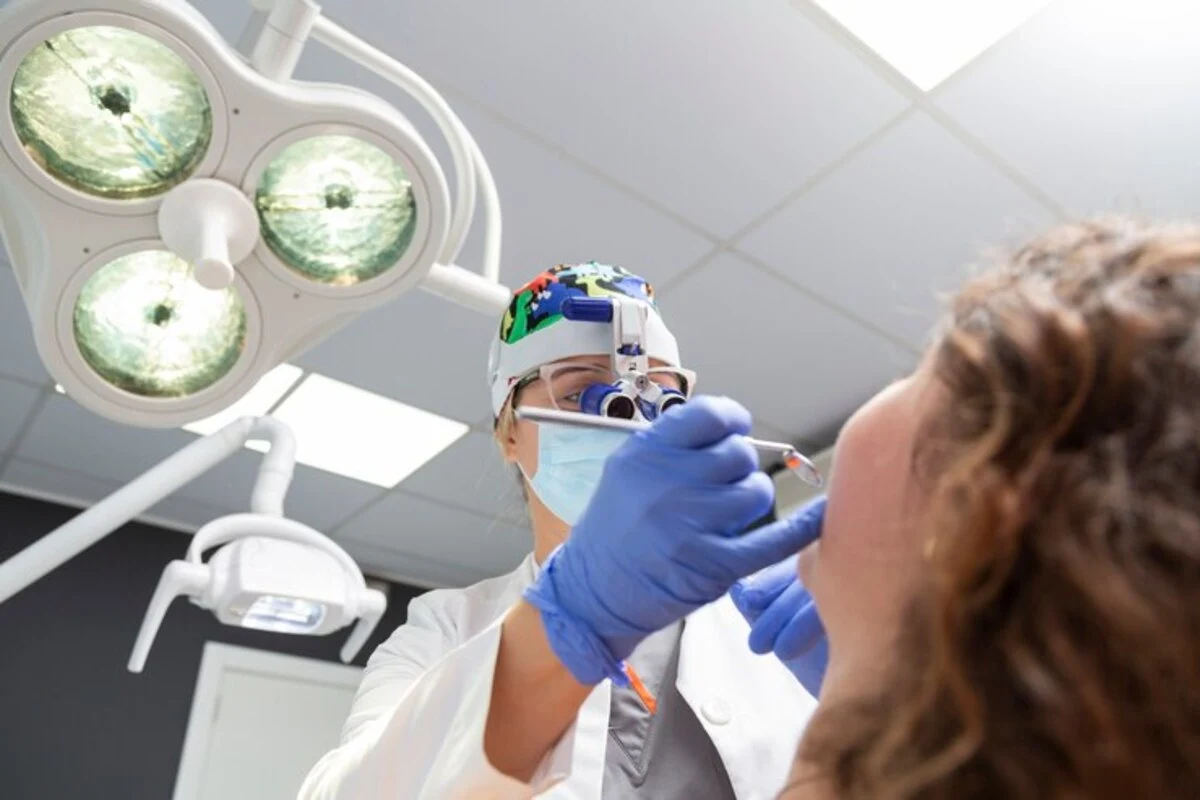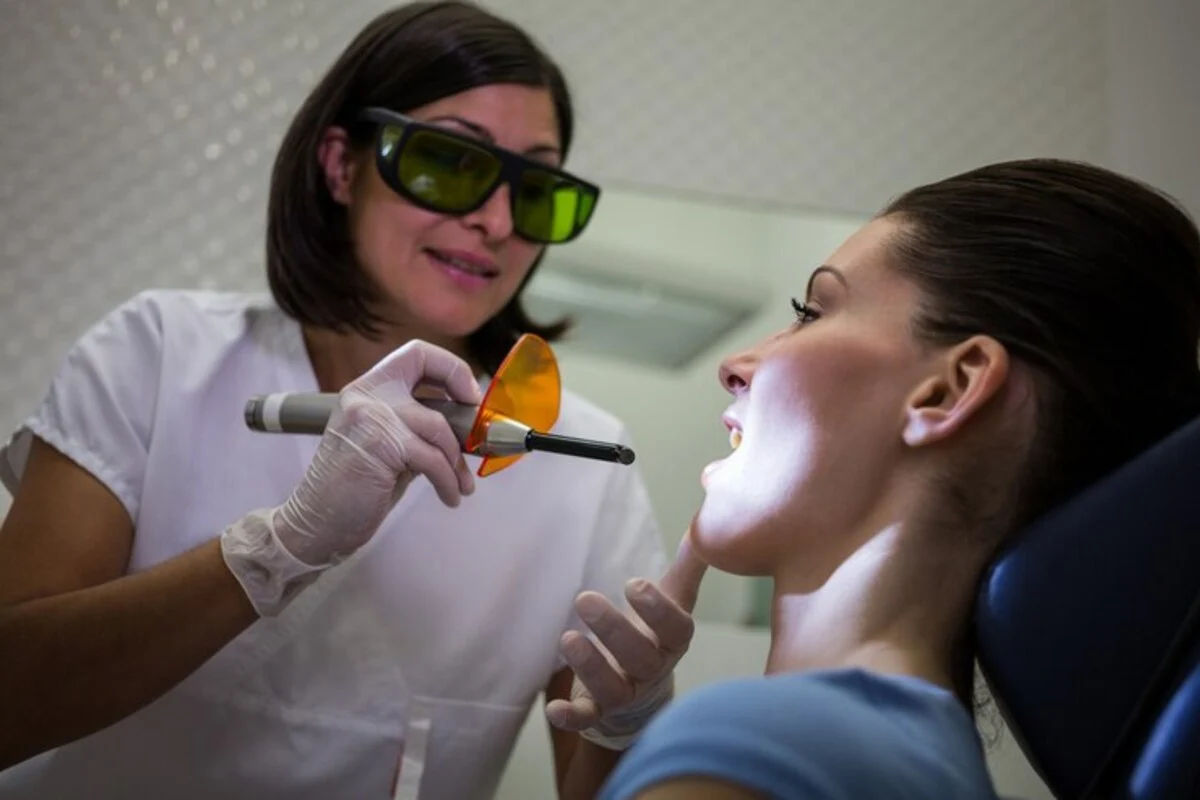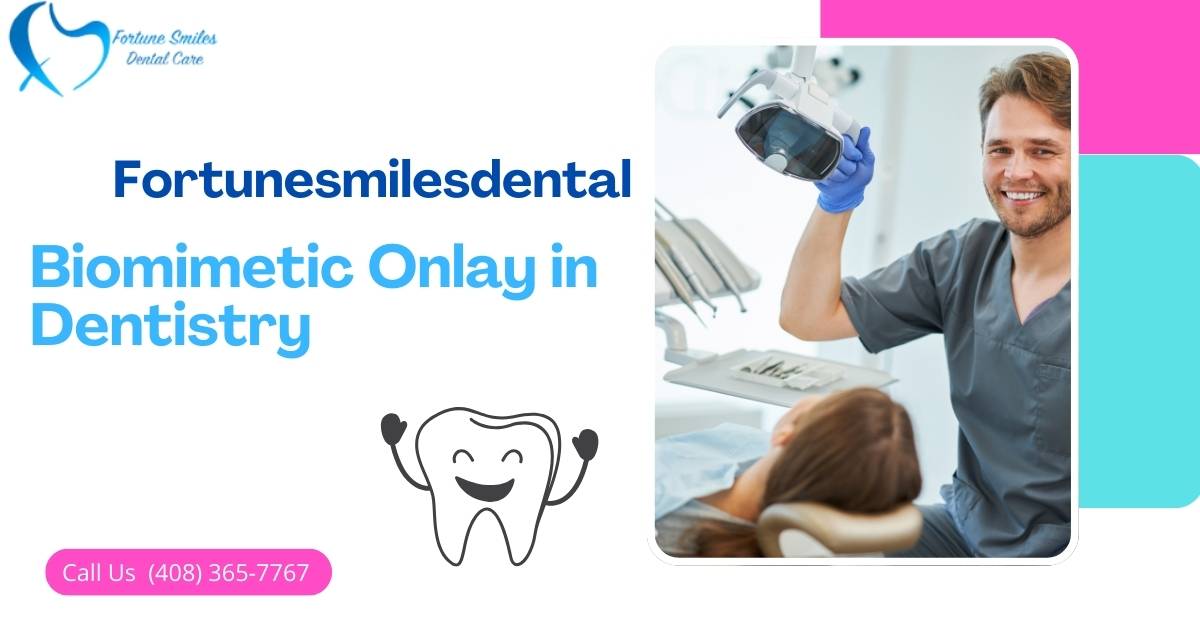A biomimetic onlay is a type of dental restoration designed to mimic the natural structure, strength, and flexibility of your tooth. Unlike traditional crowns that require significant removal of healthy tooth structure, a biomimetic onlay replaces only the damaged portion, preserving as much of the natural tooth as possible.
Think of it as the “middle ground” between a filling and a crown—offering strength and coverage while keeping your original tooth intact.
Introduction to Biomimetic Dentistry and Onlays
This approach to dental care seeks not only to repair damage but also to prevent future oral health issues by maintaining the integrity of the tooth structure. Within this framework, dental onlays represent a pivotal application of biomimetic principles, offering a conservative yet effective solution for restoring teeth that have been compromised by decay or damage.
Dental onlays, often referred to as “partial crowns”, cover one or more cusps of a tooth. Unlike full crowns that encapsulate the entire tooth, onlays are designed to cover only the affected area, preserving as much of the natural tooth as possible.
This conservative approach aligns with the biomimetic ethos of minimal intervention, which is crucial for maintaining the long-term health of the tooth.
What’s the Difference Between an Inlay and Onlay in Dentistry?
-
Inlay: Fits inside the chewing surface of the tooth (like a puzzle piece).
-
Onlay: Extends to cover one or more cusps (the raised points on your tooth).
Both can be created using biomimetic materials, which closely replicate enamel and dentin in strength and flexibility.
Biomimetic Approach to Dental Onlays
The biomimetic approach to dental onlays involves using materials and techniques that replicate the natural properties of tooth structures. The primary goal is to restore the tooth to its original strength, function, and aesthetics without the need for extensive tooth preparation that can weaken the tooth’s integrity.
This method not only restores the tooth but also mimics its natural resilience and response to biting forces, which is critical for preventing future fractures or failures.
Biomimetic Onlay vs. Traditional Crown
| Feature | Biomimetic Onlay | Traditional Crown |
|---|---|---|
| Tooth Preservation | Removes only damaged areas; conserves healthy tooth | Typically removes 60–75% of tooth structure |
| Material | Biomimetic composites/ceramics that mimic enamel & dentin | Porcelain, zirconia, or metal‑ceramic |
| Bonding & Seal | Adhesively bonded; strong seal helps block bacteria | Cemented; margins can be more prone to leakage over time |
| Strength & Biomechanics | Restores natural flexion; reinforces remaining tooth | Strong but may increase risk of fracture from heavy prep |
| Post‑Op Sensitivity | Typically lower (less drilling, better pulp protection) | Can be higher due to extensive reduction |
| Longevity | 10–15+ years with proper care | 10–15 years; retreatment may be more invasive |
| Aesthetics & Comfort | Tooth‑colored, seamless, conservative and comfortable | Aesthetic but may look bulky; more chair time for prep |
Material Selection in Biomimetic Onlays
Choosing the right materials is crucial in biomimetic onlays. Materials such as advanced ceramics and composite resins are preferred because of their ability to closely emulate the mechanical and optical properties of natural tooth enamel and dentin.
These materials are engineered to absorb and distribute chewing forces similarly to natural teeth, reducing the risk of future damage and enhancing the longevity of the restoration.
- Advanced Ceramics: Known for their durability and excellent aesthetic qualities, ceramics used in biomimetic onlays are specially treated to enhance their fracture resistance and to blend seamlessly with the natural color of the patient’s teeth.
- Composite Resins: These offer superior bonding properties and can be layered to precisely match the translucency and color variations of natural teeth, making them ideal for anterior onlays where aesthetics are particularly important.
Techniques in Biomimetic Onlay Application
The application techniques in biomimetic onlays are as crucial as the materials used. These techniques include:
Read it: Innovative Biomimetic Applications in Dental Veneers
- Adhesive Bonding: This method uses state-of-the-art adhesives that securely bond the onlay to the tooth, creating a seamless interface that minimizes bacterial infiltration and mimics the natural adherence of tooth structures.
- Digital Impressions and Milling: Modern dental practices often employ digital technologies to create precise models of the patient’s teeth. These digital models allow for the milling of onlays that fit with an accuracy previously unachievable, ensuring a perfect integration with the tooth’s natural anatomy.

Preservation of Tooth Structure
A cornerstone of biomimetic dentistry is the preservation of natural tooth structure. Biomimetic onlays require minimal tooth preparation compared to traditional crowns, meaning more of the natural tooth is preserved. This preservation is vital for maintaining the vitality of the tooth and preventing issues like root canal infections and structural weakening, which are more common in extensively prepared teeth.
In conclusion, biomimetic onlays represent a significant advancement in restorative dentistry. By integrating materials and techniques that closely mimic natural dental tissues, biomimetic onlays not only restore functionality and aesthetics but also enhance the overall health and longevity of the tooth.
This approach marks a departure from more invasive restorative techniques, emphasizing preservation and prevention, key principles of modern dental care aimed at promoting optimal oral health.
Read it: Biomimetic Approach to Dental Implants
Why Choose a Biomimetic Onlay?
1. Strength & Durability
Biomimetic onlays bond to your tooth, creating a seal that helps prevent bacteria infiltration. They also flex under pressure—just like natural teeth—reducing fracture risk.
2. Aesthetic Benefits
Made from tooth-colored materials, biomimetic onlays blend seamlessly into your smile.
3. Tooth Preservation
They require minimal drilling, which means more of your natural tooth stays intact.

Sustainability and Longevity
The sustainability of biomimetic materials and the longevity of the restorations they create are critical considerations in their development. Researchers are focusing on materials that are not only effective in their function but also environmentally friendly and economically viable in the long term.
Read it: Fortune smiles dental care services
Biomimetic onlays made from advanced ceramics and composites are designed to last longer than traditional materials, reducing the need for frequent replacements and thus decreasing the environmental impact associated with manufacturing and waste.
In conclusion, the materials and design innovations in biomimetic onlays represent a significant leap forward in restorative dentistry. By leveraging advancements in material science and digital fabrication techniques, biomimetic onlays offer a restoration option that is not only more effective and aesthetic but also more in tune with the natural function and preservation of tooth structure.
These advancements promise a future where dental restorations are not merely reparative but also preventive, contributing to the overall health and sustainability of oral care.
Clinical Benefits and Patient Outcomes with Biomimetic Onlays
The implementation of biomimetic onlays in dental practice brings a multitude of clinical benefits, directly impacting patient outcomes. This section delves into these advantages, highlighting how they contribute to improved dental health and patient satisfaction.
Enhanced Durability and Functionality
Biomimetic onlays are not just designed to mimic the appearance of natural teeth; they also replicate the functional biomechanics.
Read it: Advances in Dental Implant Techniques
This dual focus on aesthetics and functionality results in restorations that are robust and capable of enduring the typical forces exerted during chewing and biting. The use of advanced ceramics and composite materials ensures that these onlays are resistant to wear and tear, providing a long-term solution for tooth restoration.
- Stress Distribution: The precise design and customized fit of biomimetic onlays allow for optimal stress distribution along the tooth’s surface. This is crucial for preventing further damage to the remaining natural tooth structure and reducing the risk of future fractures.
- Preservation of Tooth Structure: By requiring minimal removal of the existing tooth structure, biomimetic onlays prevent the weakening of the natural tooth, maintaining its inherent strength and vitality. This conservative approach significantly contributes to the tooth’s longevity and decreases the likelihood of needing more invasive treatments in the future.
Improved Aesthetic Outcomes
Biomimetic onlays offer superior aesthetic results compared to traditional restoration methods. Thanks to advancements in material science and digital imaging, these onlays can be crafted to precisely match the color, translucency, and texture of the patient’s natural teeth.
This seamless integration not only enhances the visual appearance but also boosts the patient’s confidence in their smile.
Read it: Biomimetic Techniques in Dental Inlays: The Future of Dentistry
- Custom Color Matching: Using digital tools, dentists can achieve an exact color match with the surrounding teeth, making the onlays virtually undetectable.
- Natural Light Reflection: The materials used in biomimetic onlays possess similar reflective properties to natural tooth enamel, ensuring that the restored tooth blends perfectly with the rest of the teeth under various lighting conditions.
Minimized Post-Operative Discomfort
The minimally invasive nature of biomimetic onlay placement results in less post-operative discomfort and a quicker recovery time for patients. Since less tooth structure is removed and the procedures typically do not impact the tooth’s nerve, patients are less likely to experience sensitivity and pain after the procedure.
- Reduced Trauma: The gentle preparation and bonding techniques associated with biomimetic onlays result in less trauma to the tooth and surrounding gum tissue. This leads to a faster healing process and less postoperative sensitivity.
- Immediate Functionality: Biomimetic onlays are often fully functional immediately after placement, allowing patients to return to their normal dietary habits without a significant period of adjustment.
Long-Term Oral Health Benefits
Biomimetic onlays contribute positively to long-term oral health. By aligning closely with the natural properties of teeth and using biocompatible materials, these onlays support the overall health of the oral ecosystem.
- Enhanced Biocompatibility: Materials used in biomimetic onlays are chosen for their compatibility with the body, reducing the risk of allergic reactions or adverse effects commonly associated with foreign materials.
- Protection Against Decay: The precise fit and complete sealing of biomimetic onlays help protect against decay by preventing bacteria from infiltrating the edges of the onlays. This is particularly important for maintaining the health of the tooth’s root and preventing periodontal disease.
Read it: Shine Bright: Embracing Professional Teeth Whitening for Lasting Smiles
In conclusion, biomimetic onlays represent a significant advancement in dental restoration technology, offering benefits that extend far beyond the immediate repair of damaged teeth. These onlays improve the functional integrity, aesthetic harmony, and overall health of the oral cavity, leading to enhanced patient satisfaction and well-being.
As these techniques continue to evolve, they are set to redefine the standards of dental care, prioritizing the preservation of natural tooth structure and promoting sustainable, health-focused dental solutions.
The Future of Biomimetic Onlays
As we look towards the future of biomimetic onlays, the field of restorative dentistry is poised for significant advancements that will continue to enhance the effectiveness and scope of dental treatments. This section discusses emerging trends and technological innovations that are expected to shape the next generation of biomimetic onlays, offering even greater benefits for dental health and patient care.
Incorporation of Smart Materials
The future of biomimetic dentistry lies in the development and integration of smart materials capable of adapting their properties in response to changes in the oral environment. These materials could potentially alter their hardness, elasticity, or color to better match the surrounding natural teeth under different conditions.
- Responsive Materials: Research is underway to develop materials that can respond to temperature changes or mechanical stress by adjusting their properties accordingly. This adaptability would further enhance the durability and functionality of biomimetic onlays, making them even more like natural teeth.
- Self-healing Materials: Innovations in self-healing composites, which can repair small cracks or wear autonomously, are also on the horizon. These materials would prolong the lifespan of dental onlays and reduce the need for replacements or repairs.
Advanced Imaging and Fabrication Technologies
Technological advances in imaging and fabrication will continue to refine the precision and customization of biomimetic onlays. With improvements in 3D printing and scanning technologies, the process of designing and creating onlays will become even more efficient and accurate.
- High-Resolution Digital Scans: The use of ultra-high-resolution digital scans will allow for unprecedented detail in onlay design, capturing even the subtlest nuances of tooth morphology. This will ensure a perfect fit and optimal aesthetic results.
- 3D Printing Innovations: As 3D printing technology advances, the ability to print onlays directly in the dental office will become a reality. This will drastically reduce the time between diagnosis and treatment, providing patients with quicker restorations.
Integration with Regenerative Dentistry
Biomimetic onlays are expected to increasingly incorporate regenerative dentistry techniques. These techniques aim not only to restore function and aesthetics but also to actively promote the regeneration of natural tooth structures and surrounding tissues.
- Bioactive Materials: The use of bioactive materials that stimulate the natural remineralization of enamel and dentin could revolutionize the way onlays interact with the tooth. By actively contributing to the health of the tooth, these materials would turn restorations into agents of oral health regeneration.
- Customized Growth Factors: Embedding growth factors in onlay materials to encourage tissue integration and healing could further enhance the biological compatibility and success of biomimetic onlays.
Sustainability and Ethics in Material Sourcing
As the dental industry becomes more conscious of its environmental and ethical impact, the sourcing and sustainability of materials used in biomimetic onlays will become increasingly important. Research into more sustainable manufacturing processes and the development of biodegradable or recyclable materials will likely gain momentum.
- Eco-friendly Manufacturing: Innovations in eco-friendly manufacturing processes that reduce waste and energy use in the production of dental onlays will be crucial for reducing the carbon footprint of dental practices.
- Ethical Material Sourcing: The push for ethically sourced materials that do not compromise the ecological balance or exploit resources will influence the choice of materials in biomimetic onlays.
In conclusion, the future of biomimetic onlays looks incredibly promising, with ongoing advancements in material science, digital technology, and regenerative techniques paving the way for more sophisticated and effective dental restorations.
These innovations are expected to not only enhance the functionality and aesthetics of biomimetic onlays but also contribute to a broader commitment to oral health and sustainability. The evolution of biomimetic onlays will continue to embody the principles of biomimetic dentistry, prioritizing natural harmony and patient well-being in all aspects of dental care.

